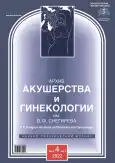Diagnostic significance of autoantibody combination in fetal growth restriction with early and late manifestation
- Authors: Yakubova D.I.1, Ignatko I.V.1, Megrabyan A.D.1, Silaeva T.M.1, Bogomazova I.M.1
-
Affiliations:
- I.M. Sechenov First Moscow State Medical University (Sechenov University)
- Issue: Vol 9, No 4 (2022)
- Pages: 203-211
- Section: Original study articles
- URL: https://journal-vniispk.ru/2313-8726/article/view/120400
- DOI: https://doi.org/10.17816/2313-8726-2022-9-4-203-211
- ID: 120400
Cite item
Abstract
BACKGROUND: Fetal growth restriction (FGR) is one of the current problems in modern obstetrics and perinatology, which is associated with a large number of adverse perinatal outcomes.
AIM: This study aimed to assess the diagnostic significance of the combination of autoantibodies (AAB) in the early and late FGR manifestation.
MATERIALS AND METHODS: The study involved 117 pregnant women, classified into Group 1 (90 women with FGR) and Group 2 (27 women with a physiological course of pregnancy). Pregnant women with FGR were divided into two subgroups depending on the time of manifestation, i.e. FGR subgroups with early and late manifestation (45 patients each), respectively. Upon hospital admission, all patients of the study groups had blood sampling to determine autoimmune AABs using the ELI-P-test.
RESULTS: An isolated increase in AABs to human chorionic gonadotropin (hCG) antigen, TrM (AAB markers of changes in vascular and hemostasis system), S100 protein, antineutrophil cytoplasm antibodies (ANCA), and KiMS (AABs to the cytoplasmic antigen of glomerular kidney cells) were observed in the early FGR manifestation when comparing the abnormal AAB spectrum in the early and late FGR manifestation, while a statistically significant isolated increase in the level of AABs to DNA and insulin was found in the late FGR manifestation.
CONCLUSIONS: The study revealed the diagnostic significance of AAB combinations, as well as the combinations of increased AAB levels to hCG, S100, ANCA, and KiMS and an increase in AABs to DNA, collagen, and S100 protein in the early and late FGR manifestation, respectively.
Full Text
##article.viewOnOriginalSite##About the authors
Diana I. Yakubova
I.M. Sechenov First Moscow State Medical University (Sechenov University)
Author for correspondence.
Email: diana_28_03_94@mail.ru
ORCID iD: 0000-0002-7561-0706
SPIN-code: 4541-8640
post-graduate student
Russian Federation, MoscowIrina V. Ignatko
I.M. Sechenov First Moscow State Medical University (Sechenov University)
Email: ignatko_i_v@staff.sechenov.ru
ORCID iD: 0000-0002-9945-3848
SPIN-code: 8073-1817
MD, Dr. Sci. (Med.), Professor, Сorresponding member of the Russian Academy of Sciences, Head of the the Department
Russian Federation, MoscowAren D. Megrabyan
I.M. Sechenov First Moscow State Medical University (Sechenov University)
Email: arentek@mail.ru
ORCID iD: 0000-0002-8542-7630
post-graduate student
Russian Federation, MoscowTatyana M. Silaeva
I.M. Sechenov First Moscow State Medical University (Sechenov University)
Email: Tatyana.s1laeva@yandex.ru
ORCID iD: 0000-0003-3330-6367
SPIN-code: 8712-0487
Assistant Lecturer
Russian Federation, MoscowIrina M. Bogomazova
I.M. Sechenov First Moscow State Medical University (Sechenov University)
Email: bogomazova_i_m@staff.sechenov.ru
ORCID iD: 0000-0003-1156-7726
SPIN-code: 9414-1218
MD, Cand. Sci. (Med.), Assistant Professor
Russian Federation, MoscowReferences
- Nardozza L, Caetano A, Zamarian A, et al. Fetal growth restriction: current knowledge. Arch Gynecol Obstet. 2017;295(5):1061–1077. doi: 10.1007/s00404-017-4341-9
- Marzouk A, Filipovic-Pierucci A, Baud O, et al. Prenatal and post-natal cost of small for gestational age infants: a national study. BMC Health Serv Res. 2017;17(1):221. doi: 10.1186/s12913-017-2155-x
- Gallego EM, Pujol AT, Bartra AJC, Roig MDG. Fetal Growth Restriction. In: Ahmed RG, Ahmet U, editors. Growth Disorders and Acromegaly. Open access peer-reviewed chapter. 2020. Available from: https://www.intechopen.com/chapters/70711
- Volochaeva MV, Baev OR. Current views on the pathogenesis of fetal growth restriction. Obstetrics and Gynecology. 2021;8:13–17. (In Russ). doi: 10.18565/aig.2021.8.13-17
- Russian Society of Obstetricians and Gynecologists. Nedostatochnyi rost ploda, trebuyushchii predostavleniya meditsinskoi pomoshchi materi (zaderzhka rosta ploda). Clinical recommendations. Ministry of Health of the Russian Federation; 2022. Available from: 2022 КР МЗ РФ Недостаточный рост плода (ЗРП).pdf. (In Russ).
- Gordijn SJ, Beune IM, Thilaganathan B, et al. Consensus definition of fetal growth restriction: a Delphi procedure. Ultrasound Obstet Gynecol. 2016;48(3):333–339. doi: 10.1002/uog.15884
- Russian Society of Obstetricians and Gynecologists, Association of Anesthesiologists and Resuscitators, Obstetrical Anesthesiologists and Intensivist Association. Preeklampsiya. Eklampsiya. Oteki, proteinuriya i gipertenzivnye rasstroistva vo vremya beremennosti, v rodakh i poslerodovom periode. Clinical recommendations. Ministry of Health of the Russian Federation; 2021. Available from: https://cr.minzdrav.gov.ru/schema/637_1. (In Russ).
- Aviram A, Sherman C, Kingdom J, et al. Defining early vs late fetal growth restriction by placental pathology. Acta Obstet Gynecol Scand. 2019;98(3):365–373. doi: 10.1111/aogs.13499
- Dubossarskaya ZM, Duka YM. Role of gene polymorphisms in genesis of gestational complications at pregnant women with obesity. Obstetrics, gynecology and reproduction. 2016;3:18–23. (In Russ). doi: 10.17749/2313-7347.2016.10.2.018-023
- Kemppinen L, Mattila M, Ekholm E, et al. Gestational iron deficiency anemia is associated with preterm birth, fetal growth restriction, and postpartum infections. J Perinat Med. 2020;49(4):431–438. doi: 10.1515/jpm-2020-0379
Supplementary files











